On Alpha Power Transformation Generalized Pareto Distribution and Some Properties
Abstract
Recently, the need to develop statistical distributions has become the most important spot. In this context, we employ the α-power transformation (APT) method to convert the generalized Pareto distribution (GPD) into a new distribution. Some statistical properties of the proposed distribution are being studied, such as moments, arithmetic mean, moment-generating function, random variables, entropy, reliability, and hazard function (HF). In addition, the proposed distribution is compared with the Pareto distribution and some other forms of alpha power distributions, such as the alpha power Pareto (APP) distribution, alpha power Rayleigh (APR) distribution, and the alpha power Lomax (APL) distribution. Finally, we demonstrate the benefits of the proposed distribution through a simulation study and two real data sets. It was found that the results showed the MLE method is reliable, the APTGP distribution is a competitive distribution for the aforementioned data set, and it is a mirror image of the Pareto distribution.
1. Introduction
The use of new standard distributions is now widespread in statistical theory. Typically, new distributions are created by combining existing distributions or adding a new parameter using generators [1]. Mudholkar and Srivastava [2] and Marshall and Olkin [3] developed a methodology for adding a new parameter to existing distributions. Eugene, Lee, and Famoye [4] proposed the concept of beta-generated distributions, where the baseline distribution can be the cumulative distribution function (CDF) of any continuous random variable and the parent distribution is the beta distribution. Jones [5] modified the idea of Eugene, Lee, and Famoye [4] and replaced beta distribution with Kumaraswamy distribution. Alzaatreh, Lee, and Famoye [6] proposed the idea of the T-X family of continuous distributions, in which the probability density function (PDF) of the beta distribution was replaced by the PDF of any continuous random variable, and instead of CDF, a function of CDF satisfying certain conditions was used. Barakat [7] constructed a new distribution family by merging a baseline CDF and its reverse, respectively, after adding and subtracting the same positive location parameter from both. He also showed how many more sorts of statistical data can be described by the proposed family than by many other considered families. Moreover, by combining, Barakat and Khaled [8] proposed a new method for constructing a family of CDFs that contains all the possible types of CDFs and possesses a very broad range of indices of skewness and kurtosis. For more details about this subject of the generation of distribution functions, see Al-Hussaini and Abdel-Hamid [9]. Bleed [10] constructed a new four-parameter Kumaraswamy reciprocal family of distributions, Bleed [11], she proposed a new exponential cumulative hazard method for generating continuous family distributions.
2. APT GPD
Here are θ the shape parameter and λ the scale parameter.
Theorem 1. The function of the new formula for the APT Pareto (APTGP) distribution is a PDF.
Proof 1. The function of the new formula for the APTGP distribution to be a PDF ifff(x) ≥ 0, ∫xf(x)dx = 1, then
Put,
Therefore, the new formula for the APT Pareto (APTGP) distribution is a PDF. The CDF of the APTGP distribution is defined as follows:
Figure 1 illustrates the CDF of APTGP distribution under different values of the parameters (θ, λ, α), and the plots of the CDF indicate increasing function, concave in shape extending to the right (θ, λ, α > 1), and convex in shape extending to the right (θ, λ, α < 1).
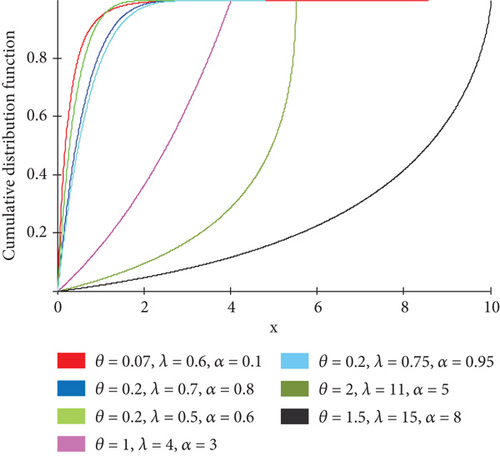
3. Some Statistical Properties of the APTGP Distribution
Moments: If X is a random variable that follows the APT generalized.
Proof 2.
Using the series,
Therefore,
Arithmetic mean: The arithmetic mean is the first moment, meaning that, put r = 1 in Equation (2); then,
Variance: Variance is the first moment about mean, meaning that, .
Put r = 2 in Equation (2), we get
Therefore, using and , we get
Moment-generating function: Moment generating function of APTGP distribution is defined as follows:
Proof 3.
Using the series,
Therefore,
Characteristic function: Characteristic function of APTGP distribution is defined as follows:
To generate data xR from a random variable that follows APTGP distribution, assume that the cumulative function is equal to the random variable U, such that U ~ unif(0, 1). Since F(x) = U, therefore, xR = λ/θ(1 − Aθ.)
where
Put U = 0.5.
The median is defined as M = (λ/θ)(1 − Aθ), A = (logα2/log(0.5(α − 1) + 1)).
Mode: To find the mode of APTGP distribution, we follow the following steps:
Differentiating the APTGP distribution function for the variable X results in
By equating the differential with zero, we get
Such that f″(t) < 0
4. Entropy of APTGP Distribution
5. The Formulation of Reliability and HF
Figure 2 illustrates the RF of APTGP distribution under different values of the parameters (θ, λ, α), the plots of the RF indicate decreasing RF, convex in shape extending to the right (θ, λ, α > 1), and concave in shape extending to the right (θ, λ, α < 1).
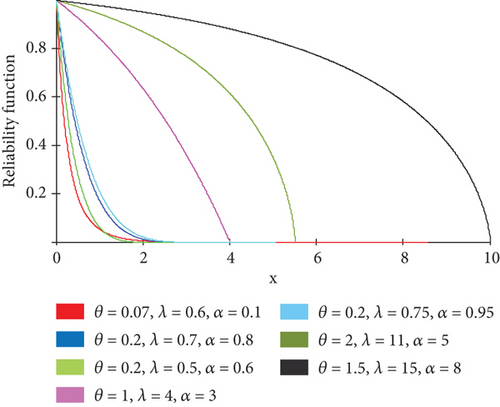
Figure 3 illustrates the HF of APTGP distribution under different values of the parameters (θ, λ, α), the plots of the HF indicate increasing HF for (θ, λ, α > 1), and for(θ, λ, α < 1).
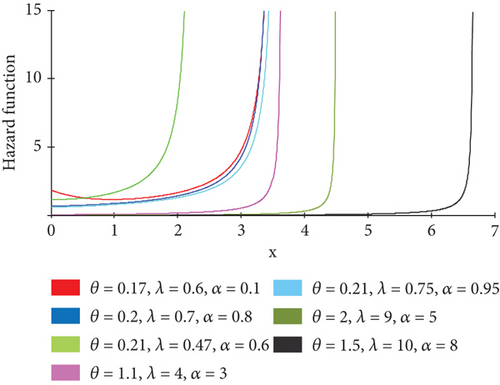
6. APTGP-Pareto Parameter Estimation
Noted that, since , then .
7. Goodness of Fit Test and Model Selection Criterions
This section presents a measurement for model fitting and two model selection criteria. They are as follows.
7.1. Kolmogorov–Smirnov Test
7.2. Akaike Information Criterion (AIC)
7.3. Modified AIC (MAIC)
The model is identical to the data if it has the smallest value of two criteria. In other words, the selection of the matching model depends on the smallest values of (MAIC) and AIC [29].
8. Simulation
The estimation of different simulated APTGP distribution data sets, each with pre-specified parameter values and varying sample sizes, is applied using the Math-Cad program. The ML method to estimate the parameter of the APTGP distribution for eight different simulated random samples of sample sizes ranging from 11 to 400 is applied.
Table 1 presents the estimates of the APTGP parameters along with their mean square error. The results show that the estimates of the parameter are reasonable for all considered random samples of all sizes, and the mean square errors decrease as the sample size increases, which gives an indication that the performance of the ML method is as good as we hope.
| n | Estimation of α | Estimation ofθ | ||
|---|---|---|---|---|
| MLE | MSE | MLE | MSE | |
| Initial values = (α0 = 1.111, θ0 = 1.001, λ0 = 0.884) | ||||
| 11 | 0.91572 | 0.0381360 | 1.00086 | 0.00000002030 |
| 20 | 1.27495 | 0.026881 | 1.00088 | 0.00000001232 |
| 60 | 1.27342 | 0.0263814 | 1.00091 | 0.00000000797 |
| 80 | 1.25675 | 0.0212428 | 1.00096 | 0.00000000170 |
| 150 | 1.11100 | 0.0000000 | 1.00100 | 0.00000000000 |
| 200 | 1.11100 | 0.0000000 | 1.00100 | 0.00000000000 |
| 350 | 1.11100 | 0.0000000 | 1.00100 | 0.00000000000 |
| 400 | 1.11100 | 0.0000000 | 1.00100 | 0.00000000000 |
| Initial values = (α0 = 1.12, θ0 = 1.25, λ0 = 1.246) | ||||
| 11 | 0.6778 | 0.1955 | 1.3585 | 0.0118 |
| 20 | 0.912 | 0.0433 | 1.3383 | 0.0078 |
| 60 | 0.954 | 0.0275 | 1.3383 | 0.0078 |
| 80 | 0.985 | 0.0182 | 1.3383 | 0.0078 |
| 150 | 1.0275 | 0.0086 | 1.3382 | 0.0078 |
| 200 | 1.0325 | 0.0077 | 1.3383 | 0.0078 |
| 350 | 1.0361 | 0.0070 | 1.3383 | 0.0078 |
| 400 | 1.042 | 0.0061 | 1.3383 | 0.0078 |
| Initial values = (α0 = 1.125, θ0 = 1.25, λ0 = 1.054) | ||||
| 11 | 0.7384 | 0.1495 | 1.3617 | 0.0124803851 |
| 20 | 0.9434 | 0.0329 | 1.2498 | 0.0000000266 |
| 60 | 1.0057 | 0.0142 | 1.2498 | 0.0000000230 |
| 80 | 1.0388 | 0.0074 | 1.2499 | 0.0000000080 |
| 150 | 1.0825 | 0.0018 | 1.2499 | 0.0000000070 |
| 200 | 1.0863 | 0.0015 | 1.2499 | 0.0000000060 |
| 350 | 1.0974 | 0.0008 | 1.2500 | 0.0000000003 |
| 400 | 1.1250 | 0.0000 | 1.2500 | 0.0000000000 |
9. Application to Real-Life Data
To illustrate the importance, usefulness, and flexibility of the APTGP distribution in practice and application, two sets of real industry and medical data were used to compare the APTGP distribution with some other competitive distributions of the Pareto model, such as the Pareto distribution, the APP distribution, the alpha power Rayleigh (APR) distribution, and the alpha power Lomax (APL) distribution. The unknown parameters for the APTGP distribution were estimated using the ML method. The K-S is used to measure the goodness of fit. In addition, AIC, MAIC, and Bayesian IC (BIC) were used to indicate the best-fit distribution of the data. The data fit the probability distribution among the probability distributions that will be referred to later if the null hypothesis is accepted, which states that “the data is fit to the probability distribution, “ and the model with the smallest value of the quality of fit measures will be the best model among them [30].
9.1. Survival Time of Infected With Virulent Tubercle Bacilli
The first data of survival time of infected with virulent tubercle bacilli was reported by [31], which is presented in Table 2.
| 2.16 | 2.18 | 2.20 | 2.20 | 2.23 | 2.34 | 2.41 | 2.45 | 2.50 | 2.59 |
| 2.63 | 2.76 | 2.86 | 2.88 | 2.94 | 2.94 | 3.03 | 3.08 | 3.10 | 3.17 |
| 3.26 | 3.51 | 3.53 | 3.55 | 3.64 | 3.84 | 3.87 | 3.89 | 4.00 | 4.14 |
| 4.16 | 4.32 | 4.41 | 4.52 | 4.56 | 4.58 | 4.58 | 5.01 | 5.28 | 5.89 |
Table 3 presents the estimates of the APTGP parameters along with their mean square error, and Table 4 shows the suitability of the data for the distribution of APTGP as well as their suitability for the Pareto distribution. This indicates that the APTGP distribution is the best in particular compared to the aforementioned competitive models, as the APTGP distribution gave the smallest value for AIC, MAIC, and BIC compared to the Pareto distribution.
| Distributions | APTGP | Pareto | AP-Pareto | AP-Rayleigh | AP-Lomax | |
|---|---|---|---|---|---|---|
| No. of parameters | — | 4 | 2 | 2 | 2 | 3 |
| Initial value | α0 | 1.7500 | — | 1.0090 | 1.0110 | 0.0095 |
| Parameter | α | 1.7740 | — | 3.8072 | 1.0006 | 0.3067 |
| Mean square error | MSE(α) | 0.0006 | — | 7.8301 | 0.0001 | 0.0883 |
| Initial value | θ0 | 1.6040 | — | 0.2500 | 0.7550 | 0.0950 |
| Parameter | θ | 1.6050 | 1.6652 | 1.2006 | 0.8025 | 0.2355 |
| Mean square error | MSE(θ) | 0.0000 | — | 0.9036 | 0.0023 | 0.0197 |
| Initial value | λ0 | — | — | — | — | 0.1870 |
| Parameter | λ | 9.4535 | 1.8121 | — | — | 0.0960 |
| Mean square error | MSE(λ) | — | — | — | — | 0.0083 |
| Parameter | ω | 0.1698 | — | — | — | — |
| Distributions | K_S* | L | AIC | MAIC | BIC | Decision |
|---|---|---|---|---|---|---|
| APTGP | 0.19713 | −65.48006 | 136.96013 | 137.62679 | 142.02676 | Fit |
| Pareto | 0.25356 | −67.40288 | 138.80576 | 139.13008 | 142.18352 | Fit |
| AP-Pareto | 0.44178 | −87.50192 | 179.00384 | 179.32816 | 182.3816 | Do not fit |
| AP-Rayleigh | 1.6610E + 3 | −3.0210E + 8 | 6.0410E + 8 | 6.0310E + 8 | 6.0310E + 8 | Do not fit |
| AP-Lomax | 0.66636 | −145.93331 | 297.86662 | 298.53329 | 302.93326 | Do not fit |
- *Critical value at 1% = 0.25773.
Figure 4 demonstrates the graphs of PDF, CDF, reliability, and HFs of the fit distributions. It is noted that the plots of the PDF and the HF of the proposed model APTGP distribution is an increasing function but the PDF of the Pareto distribution is a decreasing function. In addition, the plots of the CDF indicate an increase with decreasing RF of the fit distributions. It has been shown that the RF decreases with the passage of time, meaning that the expected percentages of survival time for those infected with a malignant infection decrease with increasing time, in contrast to the HF, which increases with time.
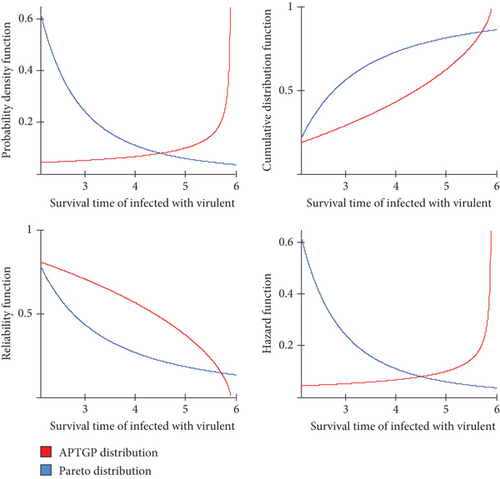
It is noted that the proposed distribution gave a mirror image of the Pareto distribution, and it proved to be a flexible distribution suitable for the data compared to the mentioned distributions.
9.2. Failure Times of the Air Conditioning System of an Airplane
The second data of the air conditioning system of an airplane was originally presented by Linhart and Zucchini [32]. The data is the failure times (weeks) of the air conditioning system of an airplane and is provided in Table 5.
| 0.1250 | 0.1190 | 0.1369 | 0.2500 | 0.2798 | 0.3095 | 0.3690 |
| 0.4226 | 0.4226 | 0.5179 | 0.5655 | 0.5357 | 0.7143 | 0.7143 |
Table 6 presents the estimates of the APTGP parameters along with their mean square error. Table 7 shows the suitability of the data for the APTGP distribution, as well as its suitability for the rest of the distributions, except that it is not suitable for the APP distribution.
| Distributions | APTGP | Pareto | AP-Pareto | AP-Rayleigh | AP-Lomax | |
|---|---|---|---|---|---|---|
| No. of parameters | — | 4 | 2 | 2 | 2 | 3 |
| Initial value | α0 | 3.20000 | — | 10.5000 | 20.0100 | 8.05000 |
| Parameter | α | 3.20530 | — | 14.4094 | 20.0015 | 12.7779 |
| Mean square error | MSE(α) | 0.00003 | — | 15.2834 | 0.0001 | 22.3527 |
| Initial value | θ0 | 1.60000 | — | 0.2000 | 0.0330 | 0.9850 |
| Parameter | θ | 1.61170 | 0.9637 | 0.2943 | 0.0195 | 0.9197 |
| Mean square error | MSE(θ) | 0.00010 | — | 0.0089 | 0.0002 | 0.0043 |
| Initial value | λ0 | — | — | — | — | 0.0650 |
| Parameter | λ | 1.15100 | 0.1190 | — | — | 0.0997 |
| Mean square error | MSE(λ) | — | — | — | — | 0.0012 |
| Parameter | ω | 1.38970 | — | — | — | — |
| Distributions | K_S* | L | AIC | MAIC | BIC | Decision |
|---|---|---|---|---|---|---|
| APTGP | 0.06463 | 2.9876 | 0.0248 | 2.4248 | 1.94197 | Fit |
| Pareto | 0.29673 | 0.75696 | 2.48607 | 3.57698 | 3.76419 | Fit |
| AP-Pareto | -0.06673 | -34.91473 | 73.82947 | 74.92038 | 75.10758 | Do not fit |
| AP-Rayleigh | 0.05263 | −93.1678 | 190.3356 | 191.4265 | 191.61371 | Fit |
| AP-Lomax | 0.23963 | -4.85036 | 15.70073 | 18.10073 | 17.6179 | Fit |
- *Critical value at 1% =0.43564.
The APTGP distribution has four parameters compared to the Pareto, Pareto power alpha, and power Rayleigh alpha distributions, which have two parameters, and the three-parameter power Lomax alpha distribution. We noticed that adding these parameters to the new distribution adds features to the distribution, making it more flexible in dealing with aspects of practical life and suitable for life tests.
The results indicated that the distribution of APTGP is the best in particular compared to the aforementioned competitive models, where the distribution of APTGP gave the smallest value for AIC, MAIC, and BIC compared with the rest of the distributions.
Figure 5 demonstrates the graphs of the PDF, CDF, reliability, and HFs of the fit distributions. It is noted that the PDFs of the APTGP distribution are increasing function, but the PDFs of the Pareto, APRD, and APL distributions are decreasing functions. The plots of the CDF indicate an increase with decreasing RF of the fit distributions. It has been shown that the RF for failure times decreases with time, meaning that the expected rates of machine performance decrease with increasing time, in contrast to the HF, which increases with time.
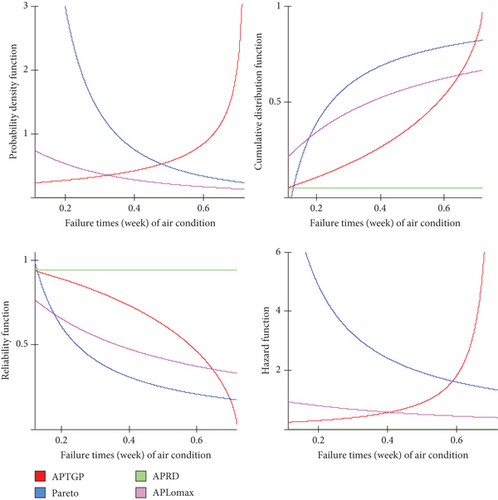
In addition, the plots of the high-frequency distribution show an increasing trend, while those of the Pareto, APRD, and APL distributions exhibit decreasing functions.
10. Conclusion
In this article, a new model called APTGP distribution was proposed, which extends the GPD in the analysis of data with real support. Expansions for the expectation, variance, moments, RF, hazard rate function, moment-generating function, characteristic function, and entropy were derived. The proposed distribution is compared with the Pareto distribution and some other forms of alpha power distributions, such as the APP distribution, the APR distribution, and the APL distribution. Also, the benefit of the proposed distribution is demonstrated through a simulation study and two real data sets. It is clear that the quality of fit values of the APTGP distribution are smaller and closer to the fit of the data than all other distributions, and it is a competitive distribution for the aforementioned data set. Accordingly, the results showed the MLE method is reliable, and the APTGP distribution is a competitive distribution for the aforementioned data set. Also, the APTGP distribution is more flexible than the other distributions, and it will provide greater flexibility in modeling real data because it is a mirror image of the Pareto distribution.
Conflicts of Interest
The authors declare no conflicts of interest.
Funding
The researchers would like to thank the Deanship of Graduate Studies and Scientific Research at Qassim University for financial support (QU-APC-2024-9/1).
Acknowledgments
The researchers would like to thank the Deanship of Graduate Studies and Scientific Research at Qassim University for financial support (QU-APC-2024-9/1).
Open Research
Data Availability Statement
The data presented in this study are available in this article.




